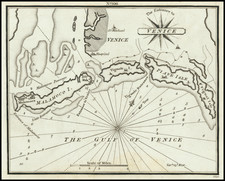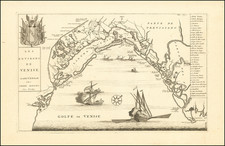A nice example of Hartmann Schedel's incunable view of Venice from the Latin edition of Schedel's Liber Chronicum, perhaps the single most influential secular illustrated book of the 15th century and one of the landmark printed works of that period.
Schedel's view of Venice is one of the earliest obtainable views of the city and realistically the only large format 15th-century illustration of the city available to collectors. The view is essentially a reduced size illustration of Venice adapted from the larger illustration of Venice in Breydenbach's Peregrinatio, which was illustrated by Dutch artist Erhard Reuwich, who was working in Mainz in the 1480s.
The view shows Venice from the south, across the lagoon. In it we see St. Mark's Square in the foreground, with various other important buildings of Venice scattered throughout the image. Gondolas navigate the canals while sailing vessels are shown in the lagoon. In the background, we see several other populated islands and the mainland.
Hartmann Schedel (1440-1514) was a physician, book collector, and writer whose most famous work, the Liber Chronicarum (Nuremberg Chronicle), included some of the first printed views of many cities in Europe and across the world.
Schedel was born and died in Nuremberg, but he also traveled for his education. From 1456 to 1463 he lived in Leipzig, where he attended the University of Leipzig and earned his MA. From there he went to Padua, where he earned a Doctor of Medicine in 1466. After university, he worked for a time in Nördlingen and then returned to Nuremberg. In 1482 he was elected a member of the Great Council of Nuremberg.
The Chronicle was published in 1493. Besides this major work, one of Schedel’s most enduring legacies is his magnificent manuscript and printed book collection, one of the largest of the fifteenth century. In 1552, Schedel's grandson, Melchior Schedel, sold about 370 manuscripts and 600 printed works from Hartmann Schedel's library to Johann Jakob Fugger. Fugger later sold his library to Duke Albert V of Bavaria in 1571. This library is now mostly preserved in the Bayerische Staasbibliothek in Munich.
Among the surviving portions of Schedel's library are the records for the publication of the Chronicle, including Schedel's contract with Anton Koberger for the publication of the work and the financing of the work by Sebald Schreyer and Sebastian Kammermeister, as well as the contracts with Wohlgemut and Pleydenwurff for the original artworks and engravings. The collection also includes original manuscript copies of the work in Latin and German.










![[Piazza San Marco / Great Fire of 1577] Augusti apud Venetos templi D. Marci accuratissima effiguratio [with] Palatii senatorii apud Venetos conflagratio](https://storage.googleapis.com/raremaps/img/small/86104.jpg)

![[Venice] Venetia](https://storage.googleapis.com/raremaps/img/small/42498.jpg)
![Le Vere Imagini et Descritioni delle Piu Nobilli Citta del Mondo [The true images and descriptions of the most noble cities in the world]](https://storage.googleapis.com/raremaps/img/small/92842.jpg)
![Piazza San Marco, Venice] Vue perspective de la superbe place de St. Marc à Venise](https://storage.googleapis.com/raremaps/img/small/90174.jpg)